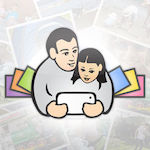Using Our Story in Pre- and Primary Schools
The design of Our Story is based around the findings from a number of areas of research.
Interest, engagement and motivation in reading
Printed books have been the traditional pathway into reading, however, most children are intrigued by new technology and so we made use of this interest and engagement. Flewitt, Kucircova & Messer (2014) have discussed the special features of digital technology, such as the way that touch provides direct control of the interface, which make it especially attractive to children.
Telling stories and narratives
There is renewed interest in the way that story-telling and narration can help the development of self-expression which is fundamental to many social and educational processes. Much of what we do involves telling others about our experiences or knowledge (Petersen, 2011; Kucirkova, Messer, Critten & Harwood, 2014; Kucirkova, Messer & Sheehy, 2017 )
Personalisation
This makes a learning experience relevant to a child, it is important to many forms of teaching, and we have evidence that it can for example help children learn new words when looking through a picture book (Kucirkova, Messer & Whitelock, 2012; Kucirkova, Messer & Sheehy, 2014a, 2014b )
Shared book reading
The frequency of shared book reading when a child and adult look through a book together has been shown to be related to later language and reading development (Meng, 2016; Sénéchal et al., 2008; Kucirkova, Messer & Whitelock, 2010 )
Creativity
Creating and making new things are important feature of children’s play (Vygotsky, 1987), we wanted to use smart technology in a way that focussed on such activities (Canning, Payler & Horsely, in press)
References not in ORO
Meng, C. (2016). Joint Book Reading and Receptive Vocabulary: A Parallel Process Model. Infant and Child Development, 25: 84–94.
Sénéchal, M., Pagan, S., Lever, R. & Ouellette, G. P. (2008). Relations among the frequency of shared reading and 4-year-old children's vocabulary, morphological and syntax comprehension, and narrative skills. Early Education and Development, 19, 27-44.
Petersen, D. (2011). A systematic review of narrative based language interventions. Communication Disorders Quarterly, 32, 207-220.
Vygotsky LS (1987) Thinking and speech. In: Rieber RW and Carton AS (eds) The Collected Works of LS Vygotsky. VoI 1: Problems of General Psychology. New York: Plenum, pp. 39–285. (Original work published 1934).
Are you already an OU student?
Request your prospectus
Explore our qualifications and courses by requesting one of our prospectuses today.
Request prospectus
